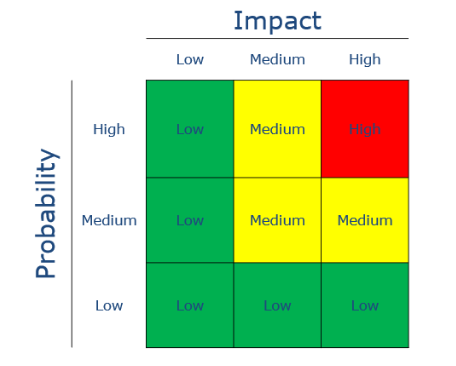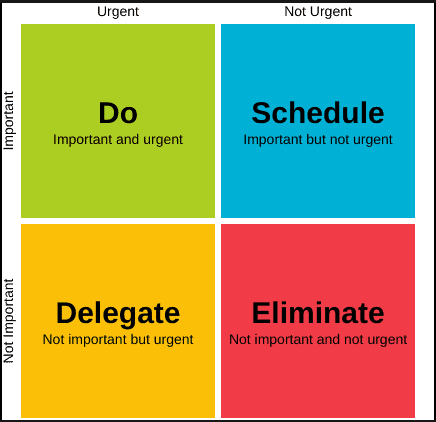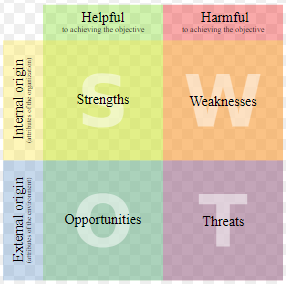There are multiple matrices that are used across programs that helps Program Managers assess the health of the program. In this blog, I have tried to capture various matrices that Pgm Managers use and a basic explanation and purpose of the same.
In this blog I have covered:
- Risk Matrix
- Stakeholder Interest Matrix
- Work Prioritization Matrix
- Stakeholder Expectation/Requirement Prioritization Matrix
- Requirement Traceability Matrix
- SWOT Analysis Matrix
- Dependency Structure Matrix
- RACI
Risk Matrix
This matrix helps to find the qualitative assessment of a risk. Based on this, the risk should be treated.
How to treat them?
If your risk falls on the green box, you can Accept the risk as the repercussions expected will be minimal.
If your risk falls on the red box, you can transfer the risk or avoid it
If your risk falls on the yellow box, you can mitigate it (ie lower the impact or probability or both)
Stakeholder Matrix
This matrix helps us to understand where each Stakeholders are in the matrix. Based on their position in the matrix, we need to engage them appropriately.
This is an extremely useful matrix which helps the Program Manager to decide the level of communication required for each stakeholder.
Manage Closely: Mostly this will be the owner of the entire program. Has high stakes. Naturally Pgm Mgr has to manage him/her closely
Monitor: Most likely to be a sub contractor (non employee) whose involvement in the program would be for a limited time.
Keep Satisfied: This is most likely to be the executives or the program sponsors. Definitely they need to be satisfied with the program progress
Keep Informed: These are most likely to be architects or SMEs or ICs who has a lot of influence, but may have lesser influence on non technical decisions.
Work Prioritization Matrix
When we have conflicting priorities from multiple projects / multiple tasks, the below matrix will help us place the tasks in the appropriate division in the matrix, there by helping us to understand how to deal with those tasks.
Stakeholder Expectation/Requirement Prioritization Matrix
It is very common for Stakeholders/customers to come up with multiple requirements in a program. However based on the program goals and objectives, program managers should identify, in which of the below box, does the need of the stakeholder fall into. That will help the Pgm Manager to negotiate and also have a good and transparent relation with the stakeholder
Requirement Traceability Matrix
This matrix helps to trace, check and validate if all requirements are delivered. The requirement flows through multiple project phases - such as impact analysis, design, coding, testing. This matrix traces the requirement across all these phases to the final deliverable.
Why is this important:
1. Every requirement is mapped to the final deliverable. So it is easier to track the scope and completion.
2. When there is a future change in the requirement, the RTVM helps us to get all the records required from analysis to testing. Future changes are easier to implement.
3. Dependency between requirements can also be easily found using RTVM. If Req x is removed, the list of reqs that depend on Req X will also be impacted. These details can be found using RTVM.
Here is a sample RTVM. As you can see, the requirement is traced until Test. You can add impact analysis document, test case results too in the below.
SWOT Analysis Matrix
This is used to evaluate a company's position in the market to know where are positioned amongst its competitors. This can be used by company to come up with a strategy to improve their position in the market.
It can also be used by a person to understand his/her strengths and weakness
Dependency Structure Matrix
The dependency matrix is very useful to find dependencies across requirements or even stakeholder dependencies. For eg., in a task dependency matrix, both the rows and columns are tasks. Tasks in the rows are tasks that have dependencies on the tasks in the column
In a very large program, this becomes very useful in scheduling the tasks and also risk of the tasks due to the dependencies.
RACI Matrix
The RACI matrix is helpful to decide the ownership and the separation of the duty for each task.
Accountable - Should be one person, who will take decisions, sign off on the task etc
Responsible - The person or persons doing the task
Consulted - The person who is generally consulted before beginning or before sign off of the task
Informed - Keep the person in loop on the progress of the task.








No comments:
Post a Comment